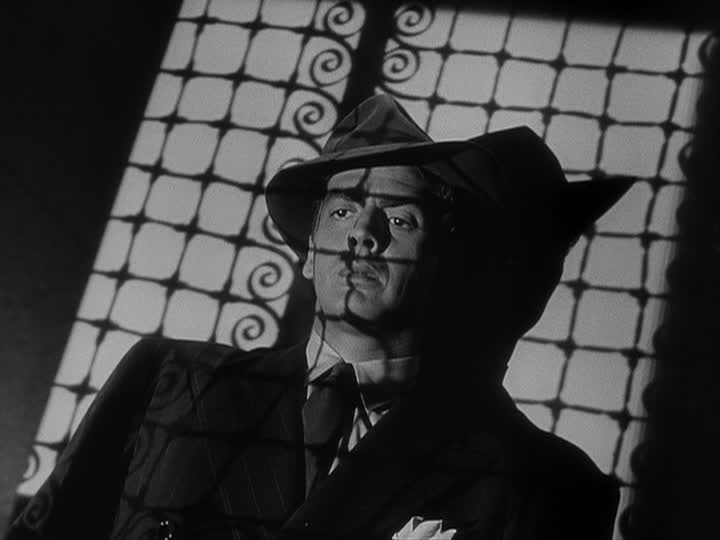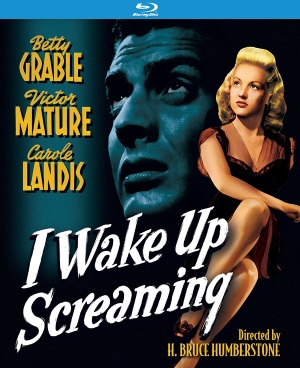 I Wake Up Screaming (Kino Lorber Studio Classics, Blu-ray) is not just one of the great movie titles of classic cinema, it is one of the films that established the distinctive style and attitude of film noir, from the blast of a headline shouting BEAUTIFUL MODEL FOUND MURDERED to the third degree given to swaggering sports promoter Frankie Christopher (Victor Mature) under the glare of a blinding lamp in a rather suspicious room of worn brick and cast-off furnishings, more of a cell than an official interrogation room. Mature is lit up in the center of the screen while hard shadows assault the walls and slashes of light and looming silhouettes give the cordon of cops wrapped around him a look more like intimidating mob hoods than New York’s finest. On the other side of the dungeon door is the public side of the detective’s room where Jill Lynn (Betty Grable), the victim’s sister, is treated more gently, but she’s just as trapped. When the camera swings around we see a cage around her. The picture opens with a punch and the backstory is quickly filled in with jabs of flashbacks, jumping back and forth between the smart mouthed dandy of a promotor and the demure young woman as they lay out the events leading up to the murder of ambitious Carole Landis, the hash slinger promoted to celebrity success by Mature like a noir Pygmalion.
I Wake Up Screaming (Kino Lorber Studio Classics, Blu-ray) is not just one of the great movie titles of classic cinema, it is one of the films that established the distinctive style and attitude of film noir, from the blast of a headline shouting BEAUTIFUL MODEL FOUND MURDERED to the third degree given to swaggering sports promoter Frankie Christopher (Victor Mature) under the glare of a blinding lamp in a rather suspicious room of worn brick and cast-off furnishings, more of a cell than an official interrogation room. Mature is lit up in the center of the screen while hard shadows assault the walls and slashes of light and looming silhouettes give the cordon of cops wrapped around him a look more like intimidating mob hoods than New York’s finest. On the other side of the dungeon door is the public side of the detective’s room where Jill Lynn (Betty Grable), the victim’s sister, is treated more gently, but she’s just as trapped. When the camera swings around we see a cage around her. The picture opens with a punch and the backstory is quickly filled in with jabs of flashbacks, jumping back and forth between the smart mouthed dandy of a promotor and the demure young woman as they lay out the events leading up to the murder of ambitious Carole Landis, the hash slinger promoted to celebrity success by Mature like a noir Pygmalion.
Who knew journeyman director H. Bruce Humberstone had such an eye for expressionist images and hard shadows? The guy was a real journeyman; he came to the film from Charlie Chan movies and Fox programmers and went on to direct a bunch of bright Fox musicals. There’s really mothing else like I Wake Up Screaming in his career and more’s the shame for it’s terrific. The film is set in New York City and shot on the Fox backlot, which gives the city scenes that slightly artificial, exaggerated quality (The swimming pool scene, there to get Mature’s shirt off and Grable in a bathing suit, is the same pool used in He Ran All the Way; (note the fountain in the middle of the pool). He guides Grable through her first real dramatic role and puts Mature in a vehicle that uses his smiling arrogance and glib confidence to great effect. Laird Cregar sets the templates for the obsessive, intimidating police detective and the stocky, soft-spoken noir heavy alike as the maverick cop determined to send Mature to the chair. He has a delicious lazy-eyed manner as he raises his chin and looks down on his suspects, a suggestion of contempt without changing expression, and he and Humberstone use his bulk to dominate and intimidate without being too overt. He’s a more measured and urbane version of the type that Charles McGraw and Raymond Burr would carry on through the genre.
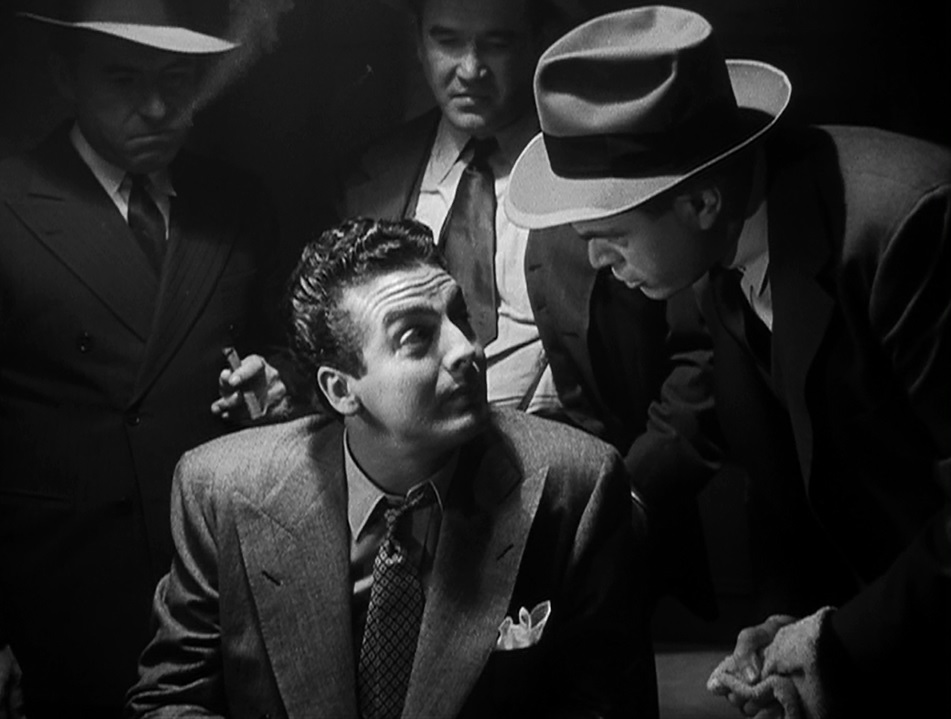
Victor Mature gets the third degree in ‘I Wake Up Screaming’
The score is technically by Cyril J. Mockridge (uncredited) but it leans on Alfred Newman’s Gershwin-inspired “Street Scene” theme, which became the unofficial theme for 20th Century Fox noir. It sets the right tone for a New York noir but the use of “Somewhere Over the Rainbow,” which weaves through the score as Grable’s theme, is a little more curious.
This appears to be a high quality HD transfer of a preservation print rather than a restoration or a transfer from the negative. There is minor damage on the reel ends, your basic wear and tear, with scuffs and scratches but nothing major, and some light vertical scratches periodically show. More apparent is the crackling on the soundtrack in a few spots, no more than a couple of seconds and not overwhelming. A good digital cleaning would have been nice but it’s a solid fine grain print with a sharp image, excellent contrasts, and rich gray scale. The clarity is superb—the wisps of smoke caught in the beams of light in the interrogation scene are at once sharp and ghostly, and it shows off the lighting in the key chiaroscuro scenes beautifully.
Carried over from the 2006 DVD is commentary by film noir historian Eddie Muller, which is full of information but also easygoing and conversational. Muller’s boxing past is evident when he criticizes the line “I own a piece of the boy in the green pants.” Boxers wear trunks, and that’s got to rankle Muller (whose father was a newspaper boxing columnist) more than it bothers your usual noir expert. It also features three minutes of stills and advertising from the film, and from the alternate campaign prepared for the film under its original (unused) title “Hot Spot.” Two supplements listed on the back cover—the alternate Hot Spot opening title sequence and the deleted scene “Daddy” (both featured on the 2006 Fox DVD release)—are nowhere to be found on the disc.
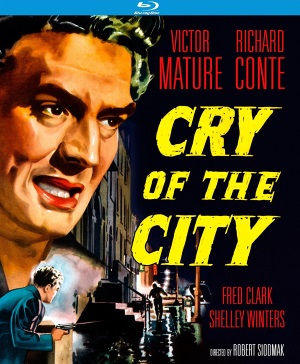 Cry of the City (Kino Lorber Studio Classics, Blu-ray) (1948) is a film noir that should be better known. It’s directed by Robert Siodmak, who made more film noirs than any other director, and it is one of his darkest, a gangster drama seeped in shadows, corruption, and psychosis, with Victor Mature (in what I believe is his best noir role) a as Lt. Candella, an Italian-American police detective who takes the pursuit of small-time gangster Martin Rome (Richard Conte) personally. They grew up together in Little Italy and Candella doesn’t buy Martin’s excuses of poverty and culture for turning to a life of crime, not with such salt-of-the-Earth parents who treat Candella almost like family. More to the point, he hates how he’s become an outlaw hero to the kids in the neighborhood and especially Martin’s adoring kid brother, Tony (Tommy Cook).
Cry of the City (Kino Lorber Studio Classics, Blu-ray) (1948) is a film noir that should be better known. It’s directed by Robert Siodmak, who made more film noirs than any other director, and it is one of his darkest, a gangster drama seeped in shadows, corruption, and psychosis, with Victor Mature (in what I believe is his best noir role) a as Lt. Candella, an Italian-American police detective who takes the pursuit of small-time gangster Martin Rome (Richard Conte) personally. They grew up together in Little Italy and Candella doesn’t buy Martin’s excuses of poverty and culture for turning to a life of crime, not with such salt-of-the-Earth parents who treat Candella almost like family. More to the point, he hates how he’s become an outlaw hero to the kids in the neighborhood and especially Martin’s adoring kid brother, Tony (Tommy Cook).
Mature gives one of his best performances as Candella, bringing a sense of gravity to a dour and humorless role, the martyr fighting the good fight in a neighborhood that has turned its back on him. Conte gets the more colorful part, flashing a grin as the wise guy hood spreading the message the crime pays and pays well, and his staccato patter has a singsong confidence that slips into arrogance. He’s the classic noir gangster, a mercenary narcissist who fools himself into thinking he has a code and then breaks it when he gets desperate. Yet they are reverse reflections of one another and their journeys are even mirrored. Shelley Winters has as small but splashy role as another of her brassy dames, loyal and not too bright, and Hope Emerson is even more memorable as Mama Rose, a hatchet-faced masseuse ready to choke the life out of Martin but for certain incriminating letters he has in his possession.
Cry of the City is one of Siodmak’s most visually striking films. He took his cast and cameras on location for some of the New York street scenes rather than shooting on the backlot where his control was greater. The urban atmosphere of city traffic and the scuffed and worn authenticity of real storefronts and sidewalks gives the film a charge of realism but Siodmak forgoes docurealism for his beloved expressionist style. He heightens the tension of
Martin’s escape through the city with webs of shadows and splashes of reflected light sparkling in the streets at night. Yet one of the most visually dense urban street scenes is created on a studio soundstage strewn with neon and set off with a forced perspective city skyline. And for the dramatic showdowns and standoffs, Siodmak clears the frame of urban bustle and clutter and picks the characters out of the shadows.
Imagery and style aside, what makes this such classic noir is the world of corruption and betrayal and desperation. Conte’s increasingly jittery performance, his smarmy confidence giving way to panic and predatory self-interest, meets Mature’s stoic stillness, the stocky Mature towering over the smaller, gnarled-in-pain Conte like a judgment. If there’s justice in this film, it’s pitiless and unforgiving, and no studio-mandated happy ending can sweep away the doom and desperation and tawdry compromises of the film’s characters.
It’s a strong transfer from a clean, well-preserved print (there is minor scuffing) with strong contrasts (and this is a film of dark, dark shadows) and a sharp image. Eddie Muller’s encyclopedic knowledge of character actors get a workout in his newly recorded commentary track, his first for a Robert Siodmak noir.
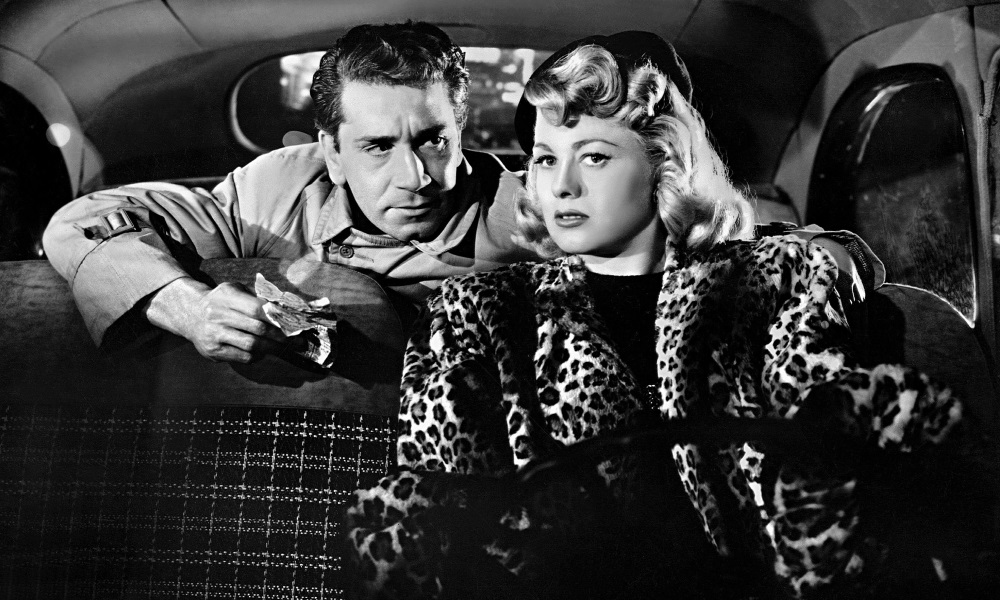
Richard Conte and Shelley Winters in ‘Cry of the City’

